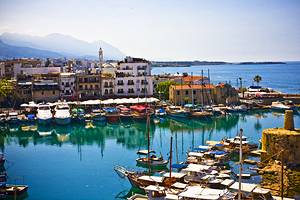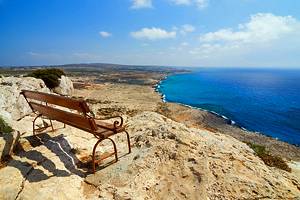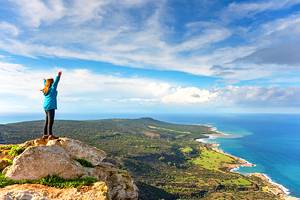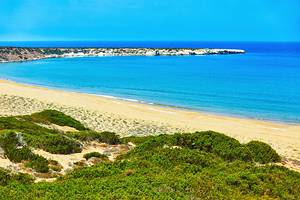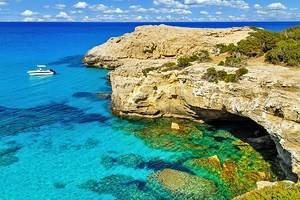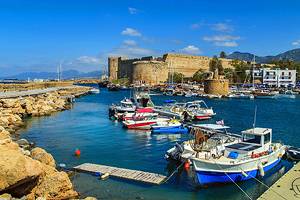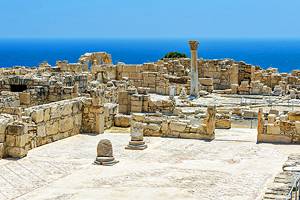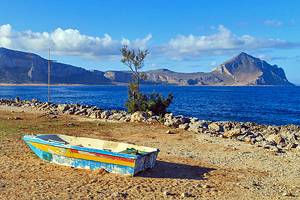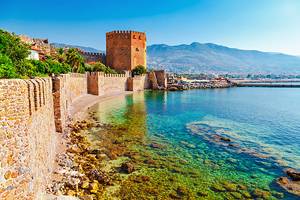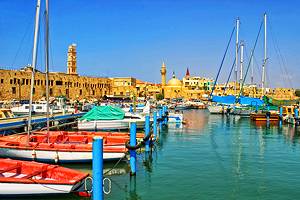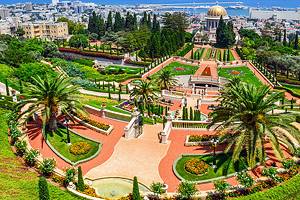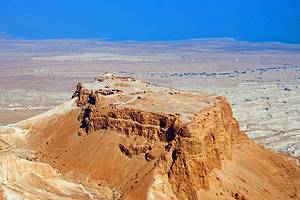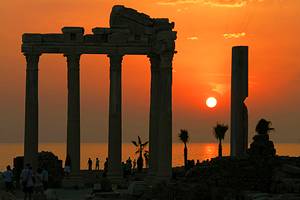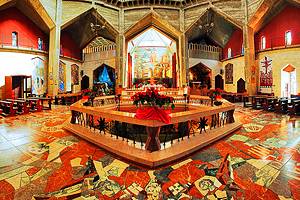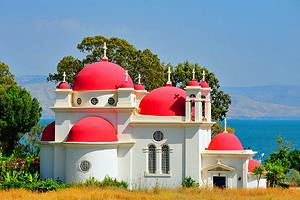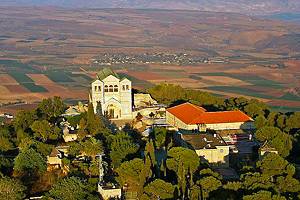Attractions & Things to Do in Larnaca
Larnaca (also called Larnaka) is one of the premier seaside resorts in Cyprus. For most visitors, the main tourist attractions here all revolve around sun, sea, and sand, with the beaches of both the town itself and farther east down the coast surrounding Agia Napa, within easy reach.

For sightseeing off the sand, Larnaca's beautiful Agios Lazaros (Church of St. Lazarus) and an atmospheric and crumbling Turkish quarter, where Larnaca's famous ceramic artisans have set up shop, are the main focus. There are major attractions below the sea surface here, too, with diving the Zenobia wreck one of the main things to do.
Larnaca is an easygoing place with a distinctive, laid-back vibe that sets it apart from the more bustling centers of Paphos and Limassol. Better yet, it's also in a prime position for forays inland to the quaint villages and places to visit of the Maheras forest region.
Begin your exploring by using this list of the top attractions and things to do in Larnaca.
- Soak Up the Sun on the Agia Napa Bay Beaches
- Admire the Interior of the Agios Lazaros
- Dive the Zenobia Wreck
- Spend an Easygoing Day on Larnaca's Beaches
- Snorkel or Dive the Museum of Underwater Sculpture (MUSAN)
- Visit Larnaca Fort
- Shop for Ceramics in Skala
- Day Trip to Stavrovouni Monastery
- Explore the Lanes of Lefkara
- Visit the Hala Sultan Tekke
- Admire the Architecture of Agia Napa Monastery
- Hike the Trails of Cape Greco
- Tour the Exhibits inside Pierides Archaeological Museum
- Stop at Kamares Aqueduct
- Delve into History at Larnaca Archaeological Museum
- Head to the Beach Resort of Protaras
- Map of Attractions & Things to Do in Larnaca
Soak Up the Sun on the Agia Napa Bay Beaches

Cyprus' most famous beaches are all in the southeast of the island around the town of Agia Napa, 45 kilometers east of Larnaka.
Top of the tourist attractions is Nissi Beach, a long stretch of perfectly white sand with an island rock outcrop just offshore that's on the western side of Agia Napa town. This is also a great destination for capturing pictures of Cyprus. Be aware that Nissi's beauty means that it can get heavily crowded in summer.
If you're trying to escape the crowds, head to Kermia Beach (two kilometers east of Agia Napa), which is smaller but just as pretty, or head to Konnos Beach (two kilometers east of Kermia Beach), which is a great choice for families with kids who want to get into the water, as the sea here is calmer than elsewhere.
Admire the Interior of the Agios Lazaros

According to local lore, after Lazarus rose from the dead, he lived here in Larnaca (then known as Kition) for another 30 years and was ordained as Bishop of Kition. When he finally died – this time for good – he was buried here, where the stately Agios Lazaros (Church of St. Lazarus) now stands.
The church was built in the 9th century by Emperor Leo VI and was faithfully restored in the 17th century.
The church has four domes over the nave, and the roof is supported on four sets of double columns. The pulpit is uniquely placed in one of these columns and is lavishly decorated in gilt. In another column is a silver icon from 1659, with a picture of St. Lazarus.
Check out the incredibly ornate iconostasis for an excellent example of Baroque woodcarving.
Beside the iconostasis, a staircase leads down into the Tomb of Lazarus (though remains found there in 890 CE – which may, or may not be of Lazarus himself – were moved to Constantinople and later to Marseille).
The church is also home to impressive paintings of the Virgin and Child and St. George and the Dragon.
Across the courtyard from the church is the Byzantine Museum which holds a collection of religious icons and relics.
Address: Agiou Lazarou (Larnaca Main Square)
Dive the Zenobia Wreck

The Zenobia wreck is Cyprus' major tourist attraction for scuba divers. In 1980, this Swedish cargo ship capsized just outside Larnaca Bay. The ship, with its cargo of tractor-trailers (which is said to have been a cargo loss of around US$200 million) has since become one of the world's top wreck dive sites.
The wreck provides dive explorations for all levels of divers with newly PADI qualified divers able to dive down to the starboard side of the ship, while more experienced divers can dive lower, down to the car decks, and enter the innards of the ship.
All dive companies in town offer Zenobia trips, as well as dive companies in Paphos and other Cypriot resort towns.
Spend an Easygoing Day on Larnaca's Beaches

Larnaca's beaches are packed from about May to September when locals and tourists alike flock to the water to cool off.
Finikoudes Beach is strung out along the main promenade and although conveniently located, is rather uninspiring and is a bit of a sardine-squeeze in peak holiday season.
Mackenzie Beach (two kilometers south from the center) is much nicer and generally has more room to throw down your towel.
If you've got your own transport though, it's much better to head slightly south to Cape Kiti Beach (15 kilometers south of Larnaca) or Perivolia Beach (one kilometer south of Cape Kiti Beach), which rarely attract more than a handful of sunbathers and are gorgeously situated in secluded coves.
Snorkel or Dive the Museum of Underwater Sculpture (MUSAN)

MUSAN (Museum of Underwater Sculpture Agia Napa) is one of the newest tourist attractions in Cyprus. This unique project – the first in the world – combines an underwater sculpture park and reef reforestation project stretching across 175 meters in Agia Napa's Marine Protected Zone.
The 93 seabed sculptures have been designed by eco-artist Jason deCaires Taylor as an underwater forest to attract marine life while also creating a fairy-tale underwater world for both snorkelers and divers to explore.
The seabed here is between eight and 10 meters in depth and, as many of the sculptures rise to eight meters high, snorkelers can enjoy good views from the surface. But to get the full experience and explore the depths of the sculpture park, you'll have to be a qualified diver.
MUSAN is based on Pernera Beach, two kilometers west of central Agia Napa and 43 kilometers east from Larnaca.
Official site: http://www.musan.com.cy
Visit Larnaca Fort

Right on the edge of Larnaca's seaside promenade, this Ottoman-era fort, built in 1625, was used as the Ottoman's main line of defense for the city. It stands on the site of a much earlier medieval fort of which nothing remains. During the British colonial period, the fort was turned into a prison.
Today, it's home to Larnaca's small Medieval Museum and displays a small collection of weaponry as well as some great black-and-white photographs of the local area.
Climbing up onto the ramparts offers good views across the Mediterranean Sea.
Across the road is Larnaca's Grand Mosque, which was once the Holy Cross Latin Church and dates from the 16th century. It's worth taking a peek inside the compound to check out the small cemetery with its old intricately-embellished tombstones.
Address: Leoforos Athinon Promenade
Shop for Ceramics in Skala

Larnaca's most interesting district to explore, the old Turkish Quarter (also called Skala) begins at Larnaca Fort and rambles south in a jumble of narrow lanes.
After Larnaca's Turkish population was forced to leave for the north during the population transfers that followed the island's division, the district of Skala was ignored and slid into dilapidation for decades.
In recent years though, this neighborhood has undergone a burst of revival as Larnaca's artisan community have begun moving their ceramic workshops here.
As the district has been ignored by modern developers, it retains much of its traditional character, with whitewashed cottages, nattily decorated with colorful window frames.
Come here to see a quaint old-fashioned architecture style that is fast disappearing in Cyprus' seaside resorts and to browse the pottery shops that are popping up within the back lanes.
Day Trip to Stavrovouni Monastery

About 40 kilometers west of Larnaca, atop a jagged clifftop, Stavrovouni Monastery sits in splendid isolation commanding superb panoramic views across the surrounding countryside. This area has long played a role in local religious rites. During Cyprus' period under Greco-Roman control, the summit here held a temple honoring the Goddess Aphrodite.
In 327 CE, Empress Helena (mother to Emperor Constantine) sponsored the building of this monastery to take the place of the temple and left a fragment of the Holy Cross in the monastery monks' possession.
At the time, Cyprus was suffering under an infestation of poisonous snakes, and local Christians believed that the holy cross installed here under the monks' care brought an end to the snake plague.
During the Arab attacks of the 15th century, the original monastery was burnt to the ground, and the current building dates from the 19th century.
Be aware that females are not allowed into the actual monastery – although they can view the grounds, which have stupendous views, and visit All Saints Church just outside the compound. Male visitors, though, are free to wander through the monastery and explore the icon laden interiors.
You will need your own transport to get here.
Explore the Lanes of Lefkara

The villages surrounding Larnaca are some of the best places to visit if you want to get a feel for traditional Cypriot life.
Famous for its lace production, the village of Lefkara, west of Larnaca, is a delightful place to explore, full of wonderfully preserved mansion architecture, quaint cafés, and a bundle of lace shops where local women sit in the sun outside creating new lace pieces for sale.
Lefkara lace gets its fame from the local story that Leonardo da Vinci bought a piece of lace here in 1481 to be used as an altar cloth in Milan's cathedral.
When you've finished shopping, the winding alleys lead you to Lefkara Local Museum which contains dioramas of traditional local life and is brimming with information on the village's history.
Afterwards, stroll on to the Church of Archangelos Michael, which holds some important 12th-century icon paintings.
The village lies about 38 kilometers southwest of Larnaca and is difficult to access by public transport, so it's best to hire a car, or take a taxi, here.
Visit the Hala Sultan Tekke

Number one on the things to do list for those seeking some nature just outside Larnaca city is the serenely beautiful Hala Sultan Tekke.
This mosque and shrine sits on the western side of Larnaca's Salt Lake, three kilometers west of central Larnaca.
An important place of pilgrimage for Muslims, this mosque honors the prophet Muhammad's wet-nurse, Umm Haram, who is said to have died at this site after falling from her donkey, and a shrine was dedicated over her tomb in 645 CE.
The present mosque building was built by the Ottomans and dates to 1816.
Larnaca's Salt Lake is a nature reserve and in spring, large flocks of flamingos and ducks can be easily seen.
During summer, the waters evaporate completely, leaving a crusty white layer of shimmering salt in their place.
The area is ringed by a walking trail, which also leads to the Hala Sultan Tekke and makes a lovely afternoon stroll.
Due to Larnaca's rather chaotic public transport system, it's easiest to get to the lake and the mosque by your own transport.
Admire the Architecture of Agia Napa Monastery

Just 45 kilometers east of Larnaca, Agia Napa is home to this famous Venetian-built monastery that sits right in the center of town. The monastery was one of the final buildings erected during the island's Venetian era.
It sits on top of a cave where an icon of the Virgin Mary was stored for safety while the destruction of the Byzantine Iconoclasm raged across the island.
The monastery was founded in the 16th century by a Venetian nobleman's daughter, who came here looking for a secluded retreat after her father refused to let her marry a commoner. She built two churches, one Catholic and one Orthodox, both of which are now under the same roof.
The fountain house in the middle of the courtyard was built as her tomb and bears pictures of her parents, herself, and a lion chasing a deer.
The church survived the Ottoman invasion unscathed and was still in use during that period, although it was abandoned in the 18th century and fell into disrepair.
By the south wall is a gateway with a pool overlooked by a huge sycamore fig tree which is said to be 600 years old.
There are hourly buses to Agia Napa from Larnaka, which drop you right beside the monastery.
Address: Plateia Seferi (Agia Napa Main Square), Agia Napa
Hike the Trails of Cape Greco

For a hike or stroll with stunning coastal panoramas head to Cape Greco, 60 kilometers east of Larnaca. This national park, set between the towns of Agia Napa and Protaras is the island's most southerly point.
The easy trails here (perfect for families wanting a nature walk, as well as more experienced trekkers) loop across the high cliffs with views sweeping across the Mediterranean beyond.
There are plenty of benches perched along the cliff edge if you want to linger and enjoy the seascape from above.
For the more active, staircases cut into the cliff allow access to some of the sea caves below.
Konnos Beach lies at the Protaras end of Cape Greco, so pack your swimsuit and cool off with a dip at the end of your hike.
As well as the coastal path, wildflower enthusiasts may want to explore the various other hiking trails that branch off from the main path, where a multitude of wild orchids grow in the spring.
There are regular buses between central Agia Napa and Protaras that can drop you right in front of the park's entrance.
Tour the Exhibits inside Pierides Archaeological Museum

This fantastic museum, set in a restored 18th-century mansion, just behind Larnaca's seafront, houses a remarkable private exhibition of Cypriot antiquities, originally collected by Demetrios Pierides (1811-1895), a Cypriot scholar and archaeologist, and further enriched by members of his family.
The museum was founded in 1839 and holds 2,500 exhibits, which range from the Neolithic to the medieval period.
In Room One, Neolithic pottery and various representations of goddesses, along with bowls used in rituals can be seen.
Move on to Room Two for more pottery with pictures of birds and fish, as well as figurines used in religious rites.
Room Three includes jugs from the site at Marion, alabaster vases, and a mask on the wall, and Room Four has pottery from the medieval period and a collection of glass, as well as some jewelry.
Address: 4 Zinonos Kitieos Street, Larnaca
Stop at Kamares Aqueduct

Built in 1746, this impressive aqueduct on the outskirts of town provided Larnaca's water supply until the 1930s.
Once part of a complicated water engineering system that used a combination of tunnels as well to deliver water into the town, it was constructed under orders of the local Ottoman governor and styled on typical Roman era aqueducts.
Today, the still sturdy 33 arches rambling across the green fields are an impressive sight.
Come during the evening when the arches are lit up, or during the day, when sheep are grazed in the fields between the arches.
You can get to the arches by hopping on any city bus that's heading in the direction of the K Cineplex.
Address: Old Larnaca-Limassol Road, Larnaca
Delve into History at Larnaca Archaeological Museum

Larnaca's Archaeological Museum is home to a collection of finds from across the surrounding region dating from the Neolithic Age to the Roman period.
The first room displays sculptures, mainly female torsos and terracotta figures, while the next room houses the pottery collection from excavations at Kition (Larnaca's ancient name) and Livadia, a village just east of Larnaca, with Mycenaean vases and a variety of ornaments in bronze, clay, and glass.
There are also some Neolithic artifacts from Choirokoitia and some glass from the Roman era.
Although the collection can be slightly haphazard and not well-labeled, it's worth stopping off here, especially to view the terracotta figures, which are supremely beautiful.
A short stroll from the museum is the archaeological site of Ancient Kition where much of the collection hails from. Although there's not much to see, check out the remnants of the Cyclopaean walls and the ruins of temples, which date back to the 13th century BCE.
Address: Plateia Kalogreon Street
Head to the Beach Resort of Protaras

Protaras is one of Cyprus' favorite seaside resorts for families on vacation. The beaches here – particularly Fig Tree Bay – have fine white sand and incredibly clear and calm waters that are great for kids to splash about in safely.
The town itself has an easygoing vibe far from the hustle and bustle of bigger resorts, and most people who holiday here come strictly for lazy beach days.
The small church of Agios Elias is on a peak beside the main road into town, and if you do feel like a short climb, the summit offers great views along the entire coast.
The bus ride to Protaras from Agia Napa only takes 20 minutes, so you can easily get a bus from Larnaca to Agia Napa and then onward to Protaras, and return the same way, in a day.
Protaras is located about 70 kilometers east of Larnaca.



